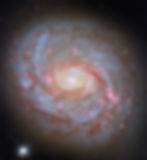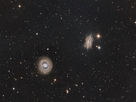Messier 77 - The Squid Galaxy 28-hour Astrophotography
- Antoine & Dalia Grelin
- Nov 4
- 5 min read
Messier 77 is a barred spiral galaxy located in the constellation Cetus. It is one of the brightest Seyfert galaxies from Earth, and is a small but great target for astrophotographers. M77 is close to several other galaxies of various shapes and sizes, which always look nice when included in your frame.
Object Designation: M77, NGC 1068
Also Known As: The Squid Galaxy
Constellation: Cetus
Object Type: Barred Spiral Galaxy
Distance: 47 million light-years away
Magnitude: 8.9
Discovery: Pierre Méchain in 1780
In this post, you will find information, images, and tips on how to photograph M77.
M77 Astrophotography from Bortle 2 Skies
October 2024
I have wanted to capture Messier 77 for a long time, but was always afraid that it would look too small through my telescope. Since I don't plan to get a larger instrument anytime soon, there was no point of waiting any further and so I decided to image it once and for all!
This was taken from a Bortle 2 observatory site in New Mexico using my RASA 8 telescope, which has a focal length of 400mm. I have done some considerable cropping to the image below, as the galaxy itself was indeed pretty small in this field of view.
On the picture below the galaxy on the left is M77, and the one on the right NGC 1055. I spent a total of 28 hours on this target, doing a mix of 60-second and 300-second exposures. The 60-second exposures helped keep the core detailed and natural.
Click the image to see it in full resolution!
GEAR USED:
Camera: ZWO ASI2600MC
Telescope: Celestron RASA 8
Mount: 10Micron GM2000 HPS
Accessories: Celestron Focuser / PrimaLuceLab Eagle 5S
Processing: Pixinsight, with R-C Astro plugins. Final touches in Skylum Luminar Neo
ACQUISITION DETAILS:
Total Exposure Time: 28 hours
Exposure Time per frame: 60 + 300 seconds
Filters: N/A
Gain: 100
How to Find M77

Messier 77 is located in the constellation Cetus, which means it is one of the more southern galaxies in the Messier catalog. To find M77, just look for the bright star Delta Ceti (Deneb Kaitos). M77 lies just about one degree east of this star.
M77 can be seen with small to medium-sized telescopes, where it appears as a small, bright core surrounded by a faint halo. With larger apertures, the central bulge and faint spiral structure might become visible, as long as you are under dark skies.
Messier 77 is best observed and photographed in the Fall and early Winter months, when the constellation Cetus is high in the southern sky during the night.
Messier 77 Information
Let's learn more about the barred spiral galaxy M77.
Discovery

Messier 77 was discovered by Messier's good friend and colleague, Pierre Méchain. He found the galaxy on October 20, 1780 and described it as a nebula.
Charles Messier double checked his discovery and added it to his famous catalog, this time categorizing it as a cluster. William Herschel did the same.
It isn't until 1850 that Lord Rosse recognized the spiral structure of M77 and properly categorized it as a galaxy.
Galaxy Information

Messier 77 is one of the closest active barred spiral galaxies visible from Earth. It is about 140,000 light-years in diameter.
A cloud of cosmic dust was found in 2022, and is reported to be hiding the supermassive black hole at the center of the galaxy.
A supernova was discovered in November of 2018.
M77 by NASA
Messier 77 was photographed by the Hubble Space Telescope, with 2 images released. The first one was shared on March 28, 2013, and the second on in April of 2025. The one you see below is the second one, which shows the galaxy in amazing details and colors.

You can see many star-forming regions, shown in red pretty much everywhere in the spiral arms. These are nebulous regions where new star are born, and there are so many!
Cool Facts About M77
It got the nickname of "Squid Galaxy" because its spiral arms look like tentacles going around the core
One of the first galaxies identified as "active"
About twice the size of the Milky Way
See the different types of galaxies on our galaxy gallery page.
Learn Astrophotography with the Galactic Course
Want to learn how to capture deep sky objects, the Milky Way, and more? Join the Galactic Course to have access to all our astrophotography courses, as well as all our processing guides!
Get courses and processing tutorials individually, or sign up for a bundle to get access to it all!
Single Shot and Processing of M77
Below you can see what a single shot of 300 seconds looks like for M77 using the RASA 8, which is f/2! This is also an unedited shot, so you can see how much I cropped out to get my final image.
Many other galaxies are visible all across the field, but difficult to see on a single shot.

Processing this data was very fun, and using an extra set of 60-second exposures was crucial to be able to end up with a nice core. I purposefully cropped out a lot of the edges right at the beginning so that I could focus all my attention on Messier 77 itself and its neighbor NGC 1055.
Check the Galaxy Processing Guide to learn how to process galaxies!
Messier 77 FAQ
In which constellation is the M77 galaxy located?
You can find M77 in the constellation Cetus.
How big is M77?
M77 has a diameter of 140,000 light-years.
How far is the M7 galaxy?
M77 is located approximately 47 million light-years away from Earth.
How long should my exposure time be when photographing M77?
I took 300-second exposures using the f/2 RASA telescope. That is a great overall exposure time for galaxies, but this one has a very bright core, so be sure to also take shorter exposures which you can later mix with the others during processing.
Should I use a filter to image M77?
You do not need filters to image this target, although you can try to also use an HA filter and see if you have star forming regions visible when you combine everything. I did not use any filter.
Final Thoughts
Messier 77 is a great target for astrophotographers who own a large or medium size telescope! With the RASA 8, the galaxy looked small at 400mm focal length but still looks great in the end. Processing was overall fun and not too complex, although it could be very challenging if your core is overblown.
Clear Skies,
Galactic Hunter
















